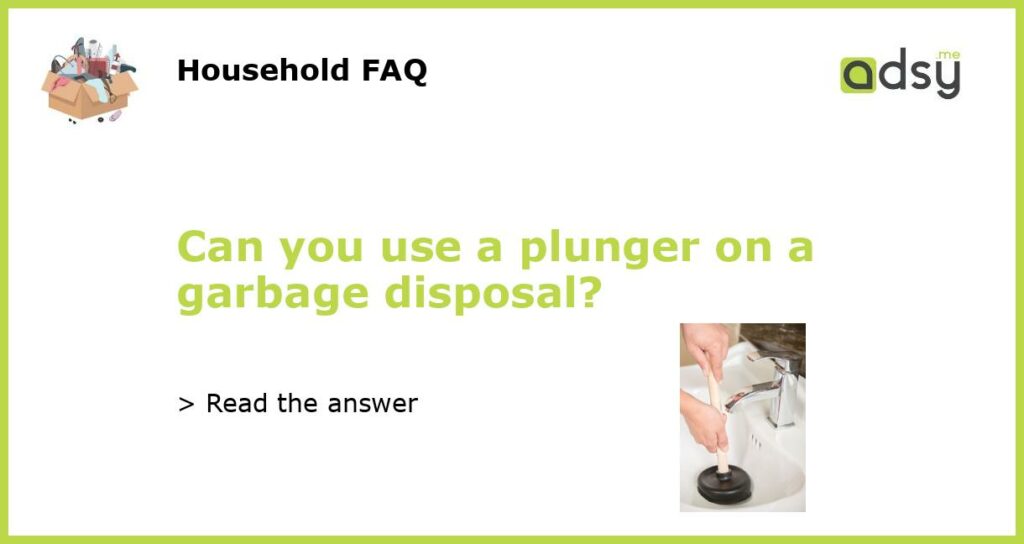Why Using a Plunger on a Garbage Disposal May Not be a Good Idea
Garbage disposals are an essential appliance in many kitchens, helping to grind up food waste and prevent clogs in your sink. However, like any appliance, they can occasionally get clogged and require maintenance. When faced with a clogged garbage disposal, many people wonder if using a plunger is a good solution. While plungers can be effective for unclogging drains, using one on a garbage disposal may not be the best idea.
The Inner Workings of a Garbage Disposal
To understand why a plunger may not be suitable for unclogging a garbage disposal, it’s essential to understand how they work. When you turn on your garbage disposal, a motor spins a flywheel that has sharp blades attached to it. These blades grind up food waste, allowing it to flow through the drain and into the plumbing system.
When a clog occurs, it is often due to larger pieces of food or other debris getting stuck in the drain or the flywheel. Many people think that using a plunger can dislodge these clogs and get the garbage disposal working again. However, plungers are designed for unclogging drains, not for the specific mechanisms of a garbage disposal.
Potential Damage to the Garbage Disposal
Using a plunger on a garbage disposal can potentially cause damage to the appliance. The force generated by the plunger may be too much for the delicate inner workings of the garbage disposal, causing the flywheel or blades to become misaligned or even break. This can result in costly repairs or the need for a replacement.
Additionally, the pressure from the plunger may push the clog further into the plumbing system, making it even more challenging to remove. This can lead to additional clogs in other areas of your plumbing, creating a more significant issue that will require professional help to resolve.
Alternative Methods for Unclogging a Garbage Disposal
If using a plunger on a garbage disposal is not recommended, what are the alternative methods for unclogging this essential kitchen appliance? Here are a few options:
1. Manual removal: One of the most straightforward solutions for a clogged garbage disposal is to manually remove the debris. Start by turning off the power to the disposal and using tongs or pliers to carefully remove any visible obstructions. Be sure to use these tools cautiously to avoid injury.
2. Allen wrench: Most garbage disposals have a small hole on the bottom where you can insert an Allen wrench. Rotate the wrench back and forth to manually turn the flywheel and dislodge any clogs. Remember to always turn off the power before attempting this method.
3. Baking soda and vinegar: Another method for unclogging a garbage disposal is to use a mixture of baking soda and vinegar. Pour half a cup of baking soda down the drain, followed by half a cup of vinegar. Let the mixture sit for a few minutes, then flush it out with hot water. This can help break up minor clogs and freshen the appliance.
4. Plumber’s snake: If the clog persists, you may need to use a plumber’s snake. Insert the snake into the drain and rotate it to dislodge the clog. This method can be more effective for more substantial blockages that cannot be easily removed by other means.
Maintaining a Clear and Efficient Garbage Disposal
Prevention is often the best approach when it comes to keeping your garbage disposal in good working order. Here are a few tips for maintaining a clear and efficient garbage disposal:
1. Avoid putting fibrous or starchy foods down the disposal, as they can create clogs.
2. Always run cold water when using the garbage disposal to help flush away debris.
3. Regularly clean your garbage disposal by grinding up ice cubes and citrus peels to freshen it.
4. Have your garbage disposal professionally inspected and cleaned on a regular basis to catch any potential issues before they become major problems.
By following these tips and learning the proper maintenance techniques, you can reduce the likelihood of a clogged garbage disposal and keep your kitchen running smoothly.






